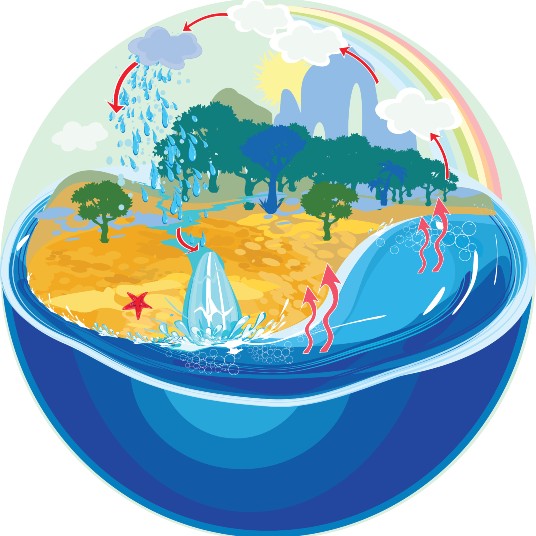Floods, drought and how climate change affects the water cycle
The temperature increases, water heats, evaporates faster, and the consequences translate into droughts and intense rainfall. This is how climate change affects the water cycle.
Drought, melting, flooding, intense rain… global warming leaves very visible proof in its wake, and it’s easy to spot how climate change affects the water cycle. A new study links the growth in these phenomena to the increase in the speed of the evaporation of water, causing a greater concentration of vapor in the atmosphere.
What will I find out from this article?
- The link between climate change and the water cycle
- How water vapor affects the lack or abundance of rain
Rising temperatures evaporate the planet’s water
 The climate is changing and with it available water resources. The phases of the water cycle (evaporation, condensation, precipitation, collection) are speeding up due to rising temperatures.
The climate is changing and with it available water resources. The phases of the water cycle (evaporation, condensation, precipitation, collection) are speeding up due to rising temperatures.
The hotter it is, the faster water evaporates, according to research published in the review Scientific Reports. As a result, the amount of vapor circulating in the atmosphere increases. The study concludes that this does not bode well and the intensification of the water cycle will provoked extreme climate events. There will be longer droughts and increasingly intense and frequent torrential rains and flooding.
Recent climate modelling predicts that, for every degree of warming, the Earth’s water cycle could intensify up to 7%. In practice, this means that humid regions could become 7% more humid and dry regions 7% drier on average.
“For every degree of warming, the Earth’s water cycle could intensify up to 7%”
This transformation in the water cycle could be the cause of the rains recorded in places they have never been seen before, such as the Antarctic, the leaders of the research point out.
How water vapor affects the lack or abundance of rain
 Water vapor is one of the essential gases in the atmosphere and most of it comes from natural processes. But changes in the water cycle increase the amount above normal levels. This results in a vicious circle. Additional water vapor favors heat retention and thus causes a faster conversion to liquid.
Water vapor is one of the essential gases in the atmosphere and most of it comes from natural processes. But changes in the water cycle increase the amount above normal levels. This results in a vicious circle. Additional water vapor favors heat retention and thus causes a faster conversion to liquid.
The effects are already being noticed in different places on the planet, where torrential rains and alarming flooding have recently taken place in areas where it rains frequently.
But the opposite is also happening. Changes in the water cycle also cause longer droughts in regions accustomed to water shortages, says a recent article in Nature. The countries most affected are Australia, and in southern Africa, where water vapor is accumulating more and more.
“Changes in the water cycle also cause longer droughts in regions where they are used to water shortages”
The research shows that this could be due to changes in man-made emissions of ultra-fine particles (UFP). These have a principal role in the condensation of clouds and, say experts, could be behind the changes in rainfall patterns.
Compared to initial reports in the 1970s, in regions where rain is normal we are seeing a greater concentration of these aerosol particles.
The UFPs reduce precipitations in relation to the time that water vapor is in the atmosphere, delaying the formation of drops of rainfall. This is contributing to regional and continental climate trends by increasing droughts and flooding, as observed recently.
The world is already experiencing important changes, many of them irreversible and with serious consequences for the future of our planet. The most recent report from the Intergovernmental Panel on Climate Change estimates that, even if we can keep global warming down to 2°C, extreme weather phenomena will be 14% more intense than at the beginning of the Industrial Revolution.
The only way to guarantee that heatwaves, droughts and storms do not intensify in future is to limit global warming. There is a long road ahead if we’re to achieve this. Time is of the essence, but it’s still possible.
Sources:
- https://www.nature.com/articles/s41598-022-11500-5
- https://www.sostenibilidad.com/cambio-climatico/ipcc-informe-mitigacion-2022/







